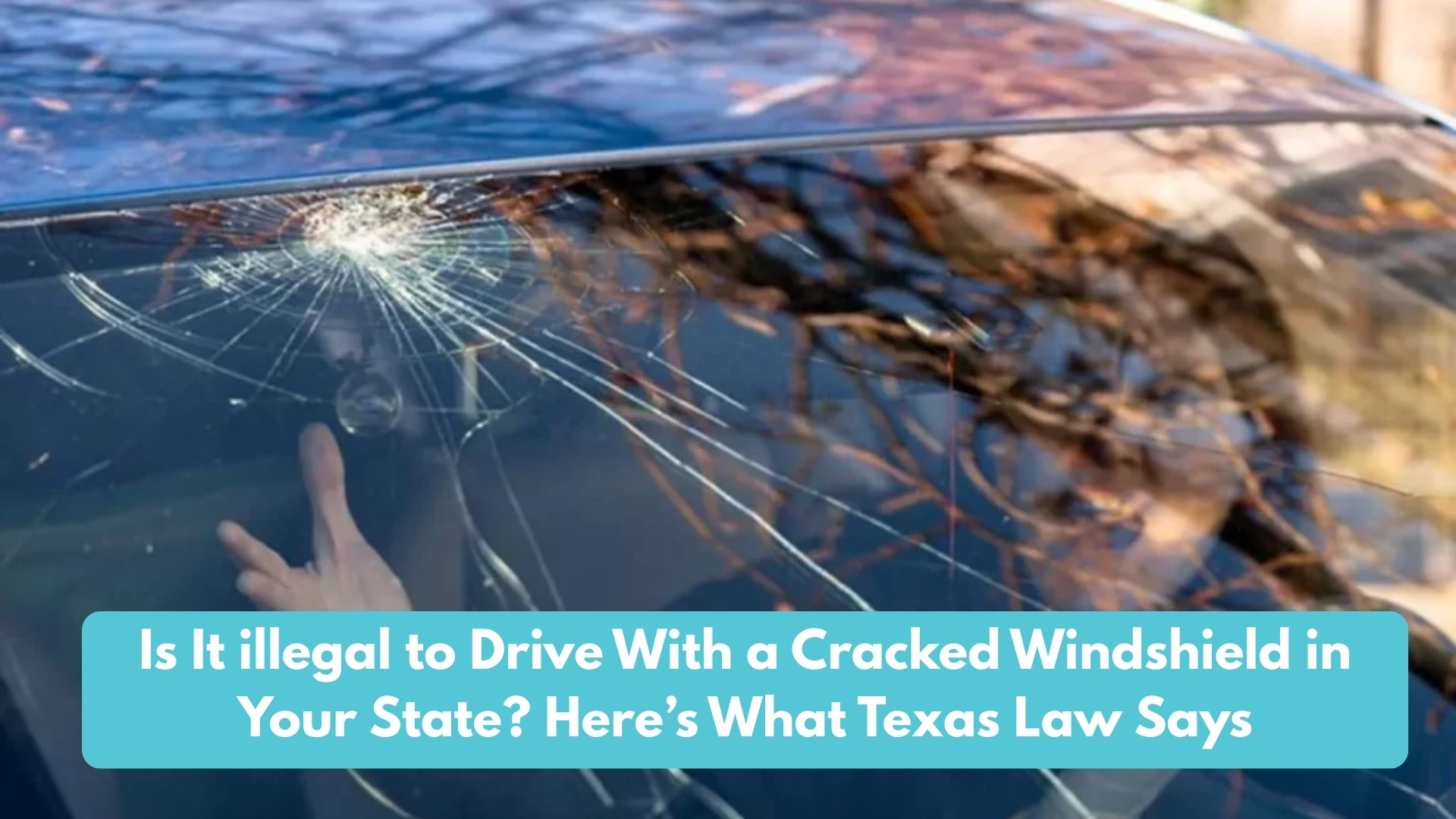A cracked windshield may seem like a minor annoyance—but it can carry real safety, inspection, and legal consequences. In some states, rules are very explicit about when a cracked windshield is illegal. For Texas, the situation is a little more nuanced: there is no outright statute that states “You cannot drive with any crack in the windshield,” but there are laws that make certain cracked or damaged windshields illegal under specific conditions. Understanding those conditions is key.
2. What the Texas statutes say (and don’t say)
What the law doesn’t explicitly say
Texas law does not have a statute that flatly says “a cracked windshield of any size is illegal to drive with.” Several sources make that clear: while a cracked windshield may be ticketed under certain conditions, there is no specific prohibition just for any crack.
For example, one law firm notes:
“Texas law does not specifically mention cracked or damaged windshields as explicitly illegal.”
What the law does say
Although there is no explicit “crack” prohibition, there are sections of the Texas Transportation Code Chapter 547 that apply to glass, visibility, and vehicle equipment. A few of the relevant ones:
- Section 547.603: Requires a motor vehicle to be equipped with a device (windshield wiper) that cleans moisture from the windshield and the device must be maintained in good working condition.
- Section 547.611 (Safety glazing material required): The law requires that when a vehicle is sold or registered, the windshield and windows must be made of safety glazing material of a type approved by the department.
- Section 547.613: Prohibits an operator from driving a vehicle with any object or material placed, displayed or attached on the windshield (unless authorized) that obstructs the driver’s view.
From these statutes, the key legal hook is obstruction of the driver’s view or compromised visibility, rather than any crack per se.
Legal interpretation
In practice, under Texas law you are more likely to be in violation if a windshield crack or chip obstructs the driver’s clear view of the road, or if the damage compromises the windshield’s structural integrity (or interferes with required equipment like wipers). Many legal summaries stress that point.
3. When a cracked windshield becomes a legal issue
Obstruction of driver’s view
If a crack or chip is in the driver’s field of vision, or if the damage distorts or blocks the view of the road, a law enforcement officer may cite you under the view‐obstruction statute. For example:
“If the crack obstructs the driver’s view … law enforcement can issue a citation as it may be considered a safety hazard.”
Vehicle inspection ramifications
Even though a crack may not be directly referenced in statute, during a vehicle inspection (or when reviewed by authorities) the nature, location and severity of the damage matter. Many sources state that if a crack is large, in the wiper‐sweep zone, affects visibility or the wiper operation, your vehicle may fail inspection.
Insurance and liability issues
Even if you’re not ticketed, having a cracked windshield could raise liability concerns if you are involved in an accident. The windshield is part of the vehicle’s safety system: it contributes to roof support in a rollover and helps ensure proper airbag deployment. Some legal blogs note that a severely damaged windshield may reduce the strength of the vehicle’s structure.
Size and location guidelines (not strictly statutory)
Although not strictly codified, many repair/inspection services cite benchmarks such as cracks longer than a few inches in the driver’s view zone being more likely to cause problems. One blog says:
“Texas law requires that any crack larger than 3 inches in diameter or within the driver’s line of vision must be replaced.”
However, this figure is not guaranteed in statute—rather, it stems from interpretation by inspections/repair shops.
4. Role of vehicle inspections in Texas
Does Texas inspect windshields?
According to the Texas Department of Public Safety (DPS) “Items of Inspection” FAQ:
“The windshield is NOT an item of inspection. However, the windshield wipers are.”
That means during an annual (or required) safety inspection, the windshield itself may not necessarily be evaluated explicitly, but the equipment related to it (e.g., wipers) is.
Recent changes
Texas is undergoing changes in how vehicle inspections are handled: starting in 2025, most non‐commercial vehicles in many counties will no longer require a safety inspection (though emissions tests may still apply in certain counties).
One blog notes:
“As part of the ongoing vehicle inspection law revisions, Texas has removed the windshield inspection from the state inspection process.”
What this means
While the inspection process may not directly reject a vehicle solely because of a cracked windshield, this does not mean the windshield damage is irrelevant. The vehicle must still be safe to drive and the driver must have an unobstructed view. So, even if the inspection passes, you could still be cited for an obstructed view or other safety‐related violation.
5. Safety and liability concerns of cracked windshields
Visibility
Any crack or chip in the windshield that falls into the driver’s “sight path” can reflect light, distract the driver, blur objects or impair clarity. This increases the chances of an accident. Repair experts stress that even “minor” chips should be fixed promptly to avoid spreading.
Structural integrity
Many vehicle manufacturers design the windshield as part of the structural support of a vehicle—especially in rollover accidents. If the glass is cracked, the strength of the windshield may be compromised. Legal commentary warns that:
“Intact windshields can support at least 50% of the roof’s strength in the event of a rollover accident.”
Airbag deployment and safety systems
Windshields are also involved in proper deployment of airbags and sometimes in supporting ancillary sensors (e.g., rain sensors, driver assistance cameras). A damaged windshield may reduce the effectiveness of those safety systems.
Legal risk in accidents
If you are involved in a crash and your windshield is cracked (especially if you knew about it and delayed repair), you may face added scrutiny from insurers or legal opponents claiming reduced safety compliance.
6. What drivers should do: repair, replace, and prevent trouble
Assess the damage
Here are some questions you should ask:
- Where is the crack or chip located? Is it in the driver’s direct line of vision (in the region the wipers sweep)?
- How long or wide is the crack? Is it spreading?
- Does the crack interfere with the wiper path, sensors, or defogger?
- Has the crack compromised the edge of the windshield (which may weaken the glass)?
Repair vs. Replacement
- Repair: Small chips or short cracks (often under an inch or so) outside the driver’s sight path can often be repaired.
- Replacement: A large crack (especially in the driver’s sight path), multiple cracks, or damage at the edge of the windshield may require full replacement.
Many repair shops say that cracks in the driver’s view zone or longer than 3 inches should be replaced.
Insurance coverage
If you have comprehensive auto insurance, many policies cover windshield repair or replacement (sometimes without a deductible). Fixing early may reduce cost compared to waiting until the damage spreads.
Maintaining your windshield
- Avoid placing heavy temperature stress (for example, pouring hot water over a frozen windshield) which can worsen cracks.
- Park in shade or use a windshield cover to reduce stress from thermal expansion.
- Address chips promptly before they spread.
- Ensure the wipers are in good condition; damaged wipers hitting a crack can worsen the damage and may itself violate Texas equipment laws (Section 547.603).
What to do before inspection (or just in general)
Even if the windshield is not specifically checked in the annual inspection, ensure:
- No cracks obstruct the driver’s view.
- Wipers operate properly and clear moisture effectively.
- No damage is interfering with vehicle safety systems.
If in doubt, get professional glass shop opinion.
7. Conclusion
In short: in Texas you can technically drive with a cracked windshield—but only if the damage does not obstruct your view or compromise safety. The critical questions are about visibility, structural integrity, and whether the damage interferes with required equipment. While the state’s vehicle inspection may not reject your car solely for a cracked windshield, law enforcement can still issue a citation under obstruction or equipment laws. And if you hit a pothole, get a rock chip, or notice a crack forming: prompt repair or replacement is the safest and most prudent approach.
By staying ahead of windshield damage, you reduce the risk of a ticket, avoid safety hazards, and protect yourself from potential liability if you’re involved in an accident. For drivers in Texas, the message is: don’t assume you’re fine just because you “got away with it once.” Address the problem proactively.











Leave a Comment